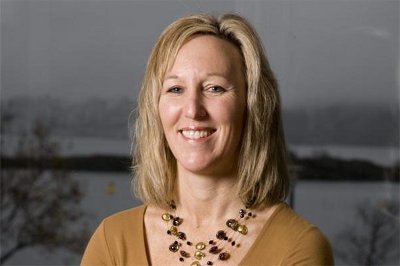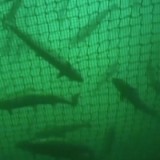Dr. Kristi Miller spent all day on the stand at the Cohen Commission yesterday in front of a packed gallery – but it wasn’t until the end of the day, when Alexandra Morton’s lawyer, Greg McDade, got his first crack at her that things got really interesting (McDade continues his questioning of Miller today).
McDade referred to Miller’s quest to reveal the identity of a mystery virus killing wild salmon as a “detective story.” And true to the genre, a clearer picture is emerging, one clue at a time – but just as new facts fall into place, more questions arise.
We had learned earlier in the week of the struggle Dr. Miller faced to get access to farmed Atlantic salmon to test them for this mystery virus. Emails from Dr. Miller to several of her colleagues, made public yesterday, suggested Miller was facing considerable pressure from inside DFO not to expand her work to farmed fish.
Under examination on the stand, we learned from Dr. Miller that the BC Salmon Farmers’ Association wasn’t very good at returning her phone calls – that is until her groundbreaking paper was published in Science. Then the phone started ringing.
Then, one week before she was due to take the stand at the Cohen Commission, the industry apparently changed its mind and volunteered to start supplying Dr. Miller’s program with fish samples from their farms.
Naturally, this won’t happen until after the Inquiry and there’s, of course, no way of knowing whether the fish farmers will follow through with their promise after the media glare of the Inquiry has faded. But it’s interesting to note the timing of their capitulation.
There were also reports in the media yesterday of Miller backing away from some of her research. But it was actually a colleague, Dr. Michael Kent – who was on the stand earlier this week as part of the Commission’s scientific panel – who was backing away from some of his earlier work, upon which Miller had been relying.
Dr. Kent had been studying a mysterious virus wiping our farmed Chinook salmon in the early 1990s. He called it “Plasmacytoid Leukemia”, while the salmon farmers called it “marine anemia.”
But Dr. Kent never finished his work and it was only this week that we learned a few things about the loose ends he left behind. He told the Commission he called it a retrovirus, even though he wasn’t sure at the time that it was a virus. He had also reported tumours behind the eyes of the fish – but later backtracked, saying he hadn’t examined them to know they were actually tumours and now thinks they may have just been inflammation.
Years later, when Dr. Miller was searching for her mystery virus, she
noted considerable symptomatic similarities between this disease defined
by Dr. Kent as “Plasmacytoid Leukemia” that was killing farmed Chinook
and the mystery virus she was pursuing. But these inconsistencies in Dr. Kent’s earlier research appear to have complicated Dr. Miller’s work on her initial hypothesis, which was that this could be the disease killing wild sockeye (these Chinook farms were on the migratory route of Fraser sockeye and Dr. Kent did find that his mystery disease could infect sockeye).
Miller’s team has recently shifted to a new hypothesis for the mystery disease, which is a “parvovirus” (a type of virus that infects many animals but hasn’t yet been found in fish). Her team is pursuing that hypothesis in the next phase of their research.
According to Miller:
- Some kind of new pathogen, thus dubbed a “novel” virus, is almost certainly helping kill millions of sockeye in the river before they spawn
- These diseased sockeye all bear a very distinct “genomic signature” (a pattern of genes that are activated to deal with certain stresses)
- Her team is working on identifying the virus causing this signature and killing the fish
In perhaps the key exchange of the day, lawyer Greg McDade asked Dr. Miller if this yet-to-be-named virus could be the “smoking gun” that best explains the recent collapse of Fraser sockeye. Miller responded, “It could be the smoking gun…But we have to do the work.” Work that will now allegedly include farmed salmon.
Finally, McDade drew Miller’s attention to two different versions of a summary of her findings to DFO staff. One of version contained a paragraph that suggested a possible link between this mystery virus and salmon farms, based on the disease killing framed fish that Dr. Kent was studying in the early 1990s. The next version looked identical – except that one paragraph was missing. What ensued was the following exchange:
McDade: “You got some blowback from DFO when you put that paragraph in your report, didn’t you?”
Miller: “I would say there was concern but I don’t think there was a large pushback…I think there was some concern around the speculative nature of that comment but I don’t recall any exact conversations about removing it.”
One final note: Earlier in the morning, Miller responded to questions from the Commission’s lawyer about her being “muzzled”. Contrary to what some media reported yesterday, Miller didn’t deny any of what has been reported by Margaret Munro and other media about her “muzzling”. Miller said she had never been prevented by DFO management from publishing any research – which was not what had been alleged by any media I’m aware of. She did however agree that she had been prevented from speaking publicly about her work and even barred from attending a closed-door academic “think tank” at SFU.
Mr. McDade’s questioning of Dr. Miller resumes this morning.




 It’s not just the industry that seems intent on keeping potentially damaging data in locked filing cabinets. The case of
It’s not just the industry that seems intent on keeping potentially damaging data in locked filing cabinets. The case of 
 And why wouldn’t it be? Canada doesn’t even ask foreign hatcheries to report ISA on the certificate they have to sign before shipping eggs to BC – and ISA was not reportable on BC farms until January of this year. Bear in mind these are the same companies operating here as in Chile.
And why wouldn’t it be? Canada doesn’t even ask foreign hatcheries to report ISA on the certificate they have to sign before shipping eggs to BC – and ISA was not reportable on BC farms until January of this year. Bear in mind these are the same companies operating here as in Chile. 